This post and the photos within it may contain affiliate links. If you purchase something through the link, I may receive a commission at no extra charge to you.
In this article, I will show you the history of calligraphy and how it evolved over more than 2000 years.
This article will mostly focus on the development of Western calligraphy and the Latin alphabet.
The purpose of this post is to present you with a clear and comprehensive calligraphy history timeline that provides you the essential information on major historical scripts that have emerged over many years.
Instead of just mentioning a bunch of different calligraphy scripts, I will take you back through time and give you a chronological overview of the major western calligraphy scripts throughout history.
Here is a quick overview of what I am going to cover in this article –
- What are the origins of calligraphy and writing?
- Western calligraphy & Latin alphabet – most influential calligraphy scripts + examples
- Additional resources on the history of calligraphy
- Final words
Get ready to travel back in time and learn more about the rich history of calligraphy!
If you want to get started with calligraphy, check out my ultimate guide for calligraphy beginners.
Let’s begin.
Before we start
There are a few things that I would like to mention.
Reviewing more than 2000 years of history in a single article is quite difficult, and obviously, I compressed the whole thing and just mentioned the most influential scripts.
I want to give you an idea of how handwriting developed in the western world.
And in case you want to learn more about it, I left more resources at the end of the article for you to check out.
I will provide additional resources (if any) for each script for you to learn from.
If you believe I made a mistake in this article, please do not hesitate to reach out – I would appreciate that.
Without any further delays, let’s begin.
What are the origins of calligraphy and writing?
The word calligraphy comes from the Greek Kallos and Graaphien, meaning beautiful and writing.
However, before calligraphy became known as an art form, it was just considered writing.
Writing has been integral to human civilization, from recording thoughts and ideas to sharing information and preserving knowledge.
Writing has played a major role in society’s development as we know it today.
The very first known record of writing dates around 3500 years BC in Mesopotamia (present-day Iraq). This is known as the Cuneiform script, which mainly consisted of making marks on wet clay tablets.
![Tablet with proto-cuneiform pictographic characters (end of 4th millennium BC), Uruk III. This is thought to be a list of slaves' names, the hand in the upper left corner representing the owner.[24]](https://www.lettering-daily.com/wp-content/uploads/2023/04/P1150884_Louvre_Uruk_III_tablette_ecriture_precuneiforme_AO19936_rwk-1024x921.jpg)
Origins of the alphabet
According to paleographers and historians, the origins of the alphabet can be traced back to Phoenicia around 1200 B.C. As Phoenician merchants embarked on their voyages across the Mediterranean, the Greeks, captivated by its efficiency, embraced the Phoenician alphabet during the eighth or ninth century B.C.
Following suit, the Etruscans not only adopted but also tailored the Phoenician alphabet to suit their own language and culture. This adapted alphabet, in turn, found its way into the hands of the Romans.
By the first century B.C., the Romans had already developed several script variations employing the Latin alphabet, marking significant developments in its evolution.

It’s important to note that writing and calligraphy is a broad term, and they appeared and evolved across different cultures worldwide. With that in mind, calligraphy and writing can be primarily divided through different cultures, such as –
- Chinese
- Western
- Indian
- Arabic
- Japanese
- Tibetan
- Etc.
In this article, I focus on Western calligraphy (the Latin alphabet), and how it developed throughout more than 2,000 years of history.
I will look closely at some of the most influential scripts that are popular and still practiced today.
Quick note – The term hand is used to describe how the writer interprets the script.
It’s also important to mention that a specific calligraphy script can be done in different styles.
My friend Jake Rainis created a perfect example of how the same calligraphy script can be done in multiple styles.
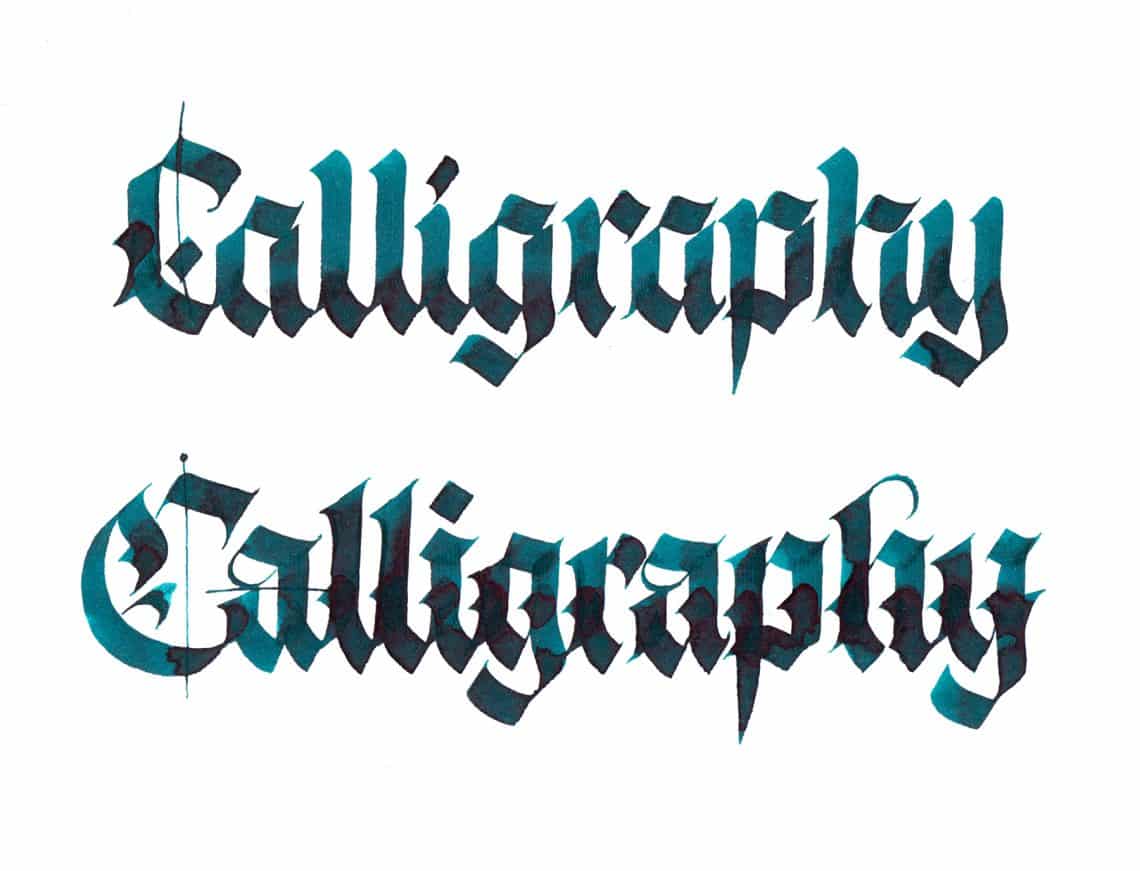
Western calligraphy & Latin alphabet – most influential calligraphy scripts + examples
These are some of the most influential historical periods that impacted the development of calligraphy in the context of the Latin alphabet (western calligraphy).
- Antiquity – Roman Empire
- Post Roman – Uncial & Insular period
- Middle ages
- Renaissance
- Baroque
- Modern
I will review each of these periods and mention the most important scripts.
Antiquity – The Roman Empire
The Latin alphabet dates back to around 700 BC, and the Roman Square Capitals emerged around the first century AD in Rome.
Roman Capitals
Even though it’s one of many scripts from that era, it is by far the single most influential historical script.
The beauty and the key of these letters lay in geometry and precision. One could say it reflects the finesse of the architecture and culture of that era.
This script served as a fundamental basis for the Latin alphabet’s historical development and, essentially, how we communicate in writing today.
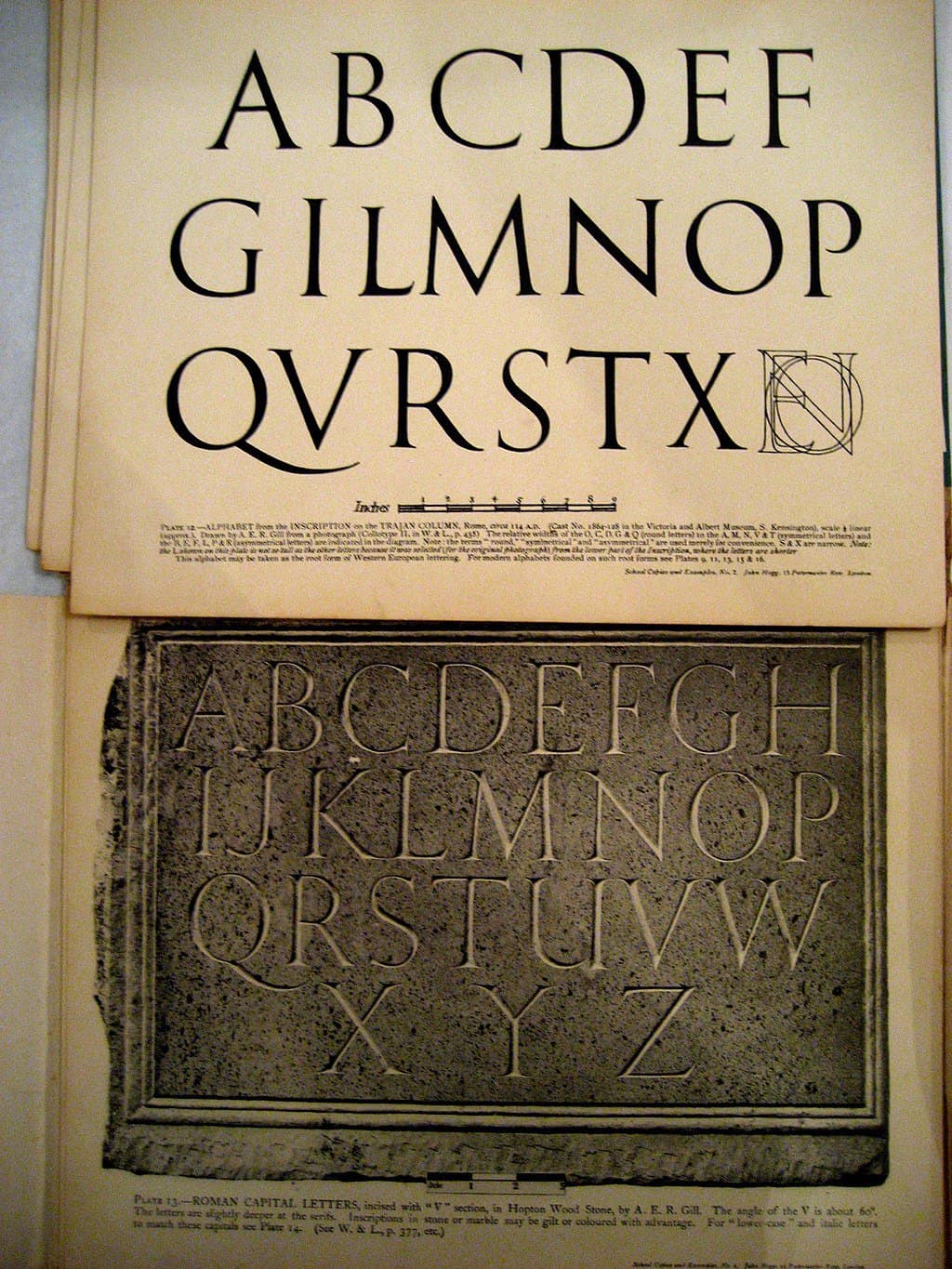
Here is a great video example by Nicoló Visioli that demonstrates how to write the Roman Capitals with a flat brush –
Rustic Capitals
Along with the Square Roman Capitals, we can distinguish another very influential (similar) script called the Rustic Capital.
Emerging in the same period, they were mostly painted with flat brushes or nibs as a more common script for everyday use –
Opposed to the Square Roman Capitals that were being used for stone engraving and more formal occasions.
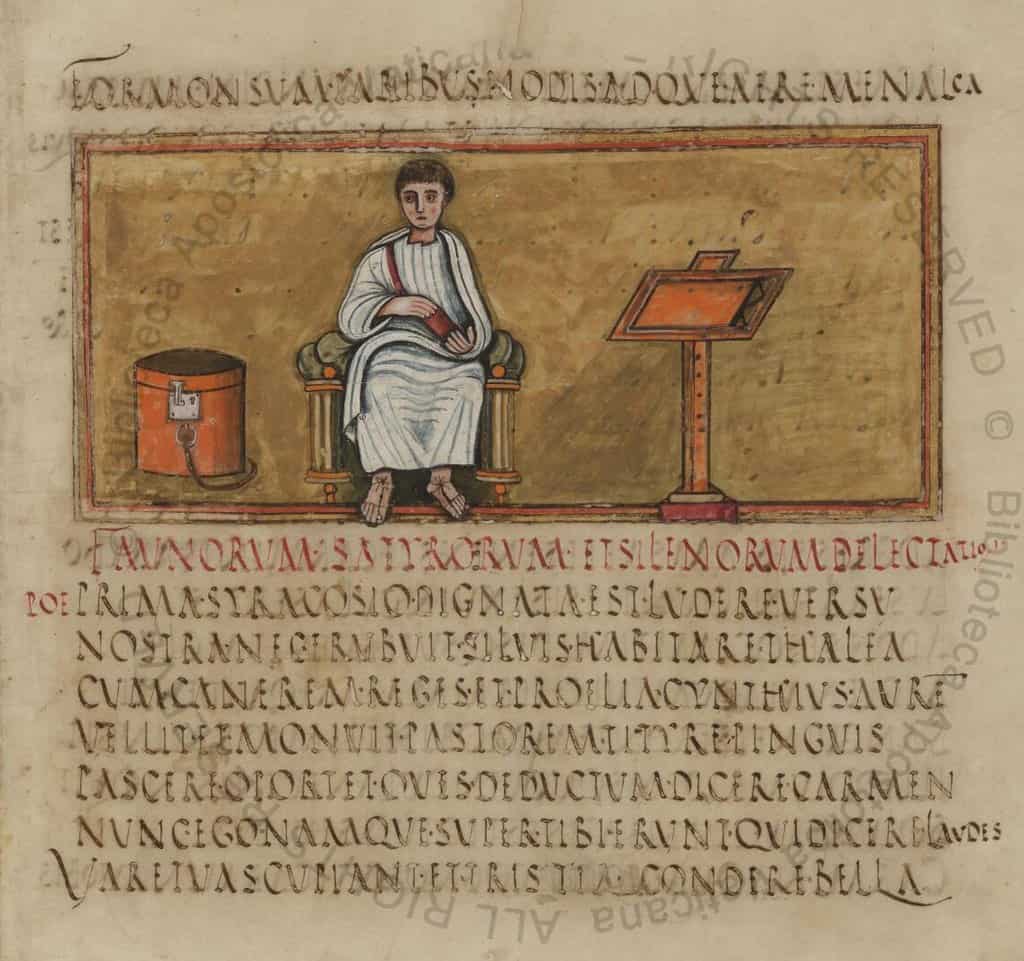
Here is another example from Pinterest
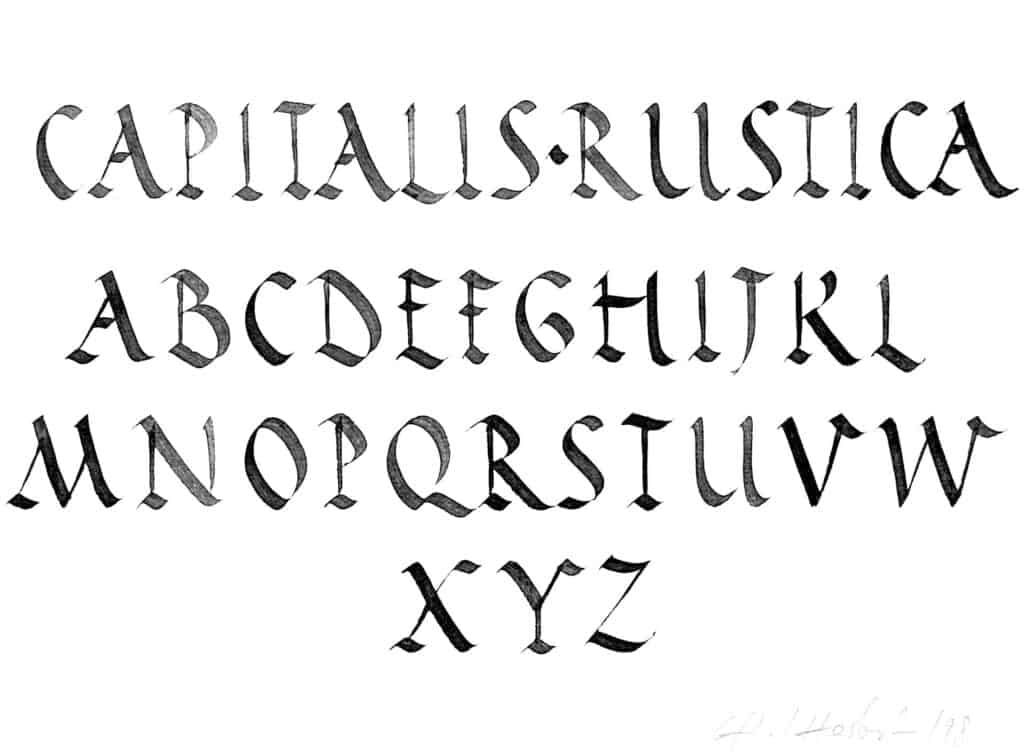
The Post-Roman Era
The Uncial script
Several hundred years later (second or third century AD), a new script developed influenced by the Greek alphabet.
The Uncial script was one of the early alphabets used in Christian texts.
Aside from its beauty, it was a more practical and speedily written script, ideal, for example – copying the Holy Bible or other manuscripts.
Bold and curved strokes characterize it, and it took fewer strokes to complete a letterform compared to the Roman Capitals.
In the Uncial script, we slowly start noticing the development of lowercase letters (aka Minuscules).
I find it extremely fascinating how the alphabet developed according to their need.
We can distinguish a few notable variations of the Uncial script.
The three most notable variations of Uncial calligraphy are –
- Uncial
- Half-Uncial
- Artificial Uncial
Here you can see a magnificent example of the Insular Half-Uncial from the Book Of Kells dating back from the 9th century.
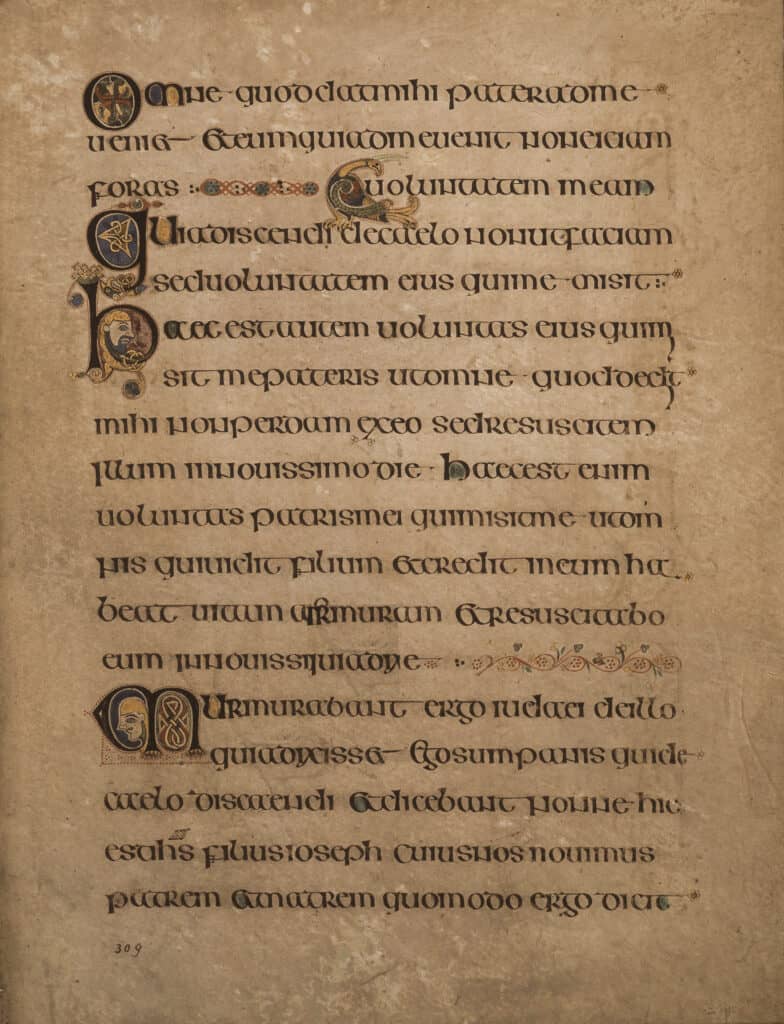
The Insular Half-Uncial is another variation of the Uncial script that originated in Ireland in the 7th century.
The Artificial Uncial is the latest alternation of the Uncial script that emerged in the early 8th century.
Its origins can be traced back to Southern England. The Artificial Uncial is a more elaborated version of the Uncial that introduces back the serif along with other more complex pen twists to achieve a more dynamic look from the letterforms.
Here is a beautiful example of the Artificial Uncial from @thundy84
The Early Middle Ages
As the Roman Empire spread across other European countries through the coming years, it eventually reached the northern parts of Europe, including England – bringing their language and the Roman alphabet.
Over the following centuries, Western Europe entered the dark ages, followed by a decline of the Roman Empire.
The Beneventan Script
During this period, a new script developed that was influenced by the Uncial script, yet it developed its characteristics – one of them being ligatures (connecting strokes).
The Beneventan script originated from the southern parts of Italy, and it was one of the longest-lasting Post-Roman scripts.
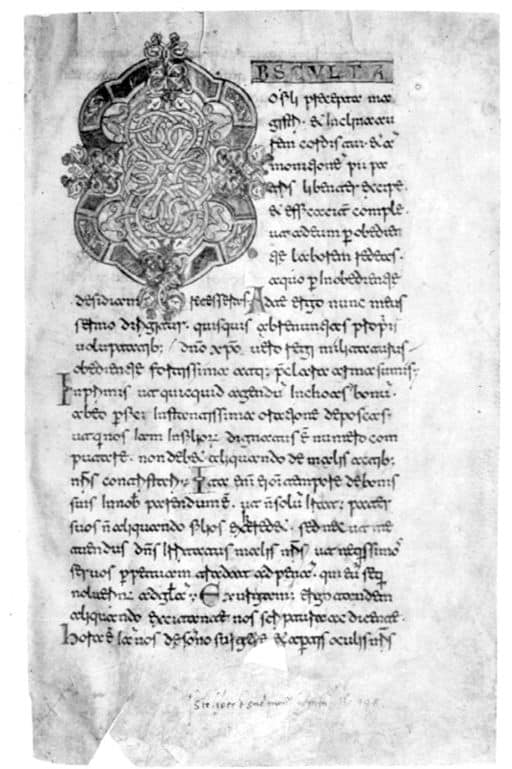
The Carolingian Minuscule
One of the most important scripts of the medieval era was the Carolingian script which was developed during the rule of Charlemagne in the late eighth century.
Charlemagne assigned Alcuin (Monk of York) to be his librarian and teacher and to copy both religious texts and manuscripts as well as other texts of science and literature dating from the Greek and Roman era.
Alcuin, along with his team of scribes in a scriptorium based in Tours (France), developed a more streamlined script that served as a basis for the lowercase alphabet that we use today.
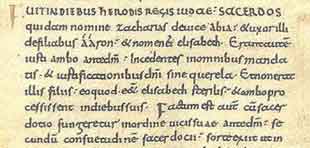
Here is another great example of the Carolingian script by my friend Paul Antonio –
The Insular Script
Another important mention of this era is the Insular script.
A medieval script developed in Ireland, and it was influenced by the scripts from the Roman era.
This particular script was influenced by Irish Christianity, which helped spread the script across England and continental Europe.
One of the most well-known examples of the Insular script is the Book of Kells (among many others)
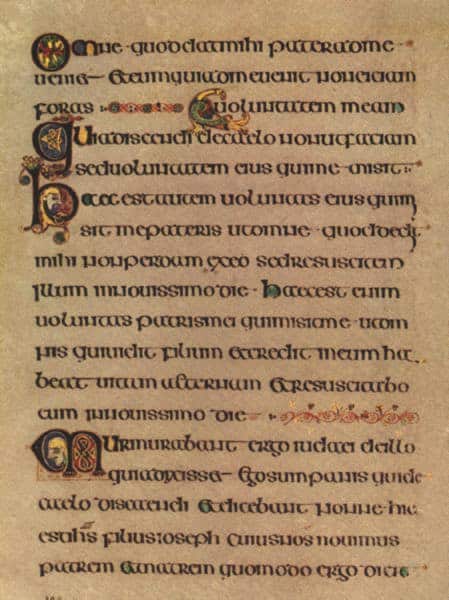

The Middle Ages – Gothic Period
Following the post-Roman era, a new script developed in Northern Europe (12th century).
The Gothic scripts are VERY popular today, practiced by many calligraphers – several different scripts (styles) developed throughout this period.
The Gothic script grew out of Protogothic and Romanesque periods. Gothic had its influence from the Carolingian script during the Charlemagne era.
However, the changes were more noticeable this time in the new Gothic script.
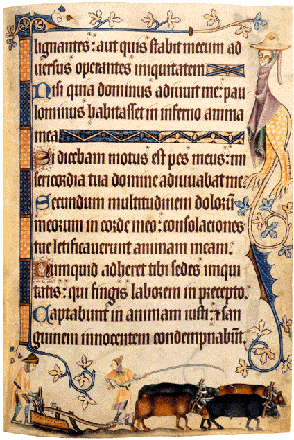
Characterized by more compressed, thick, straight, and angular shapes, it was the opposite compared to the round shapes that characterized the Carolingian script.
Although the Carolingian script was beautiful, it was time-consuming and took more space per page due to its round shapes and counterparts.
Once again, the way of writing was adapted to the current need of the people – which at the time was a higher demand for handwritten books.
Blackletter (Gothic) scripts also include different (similar) styles that evolved in different parts of Europe, such as –
- Textura Quadrata
- Textura Presciscus
- Batarde
- Fraktur
- Rotunda
- etc.
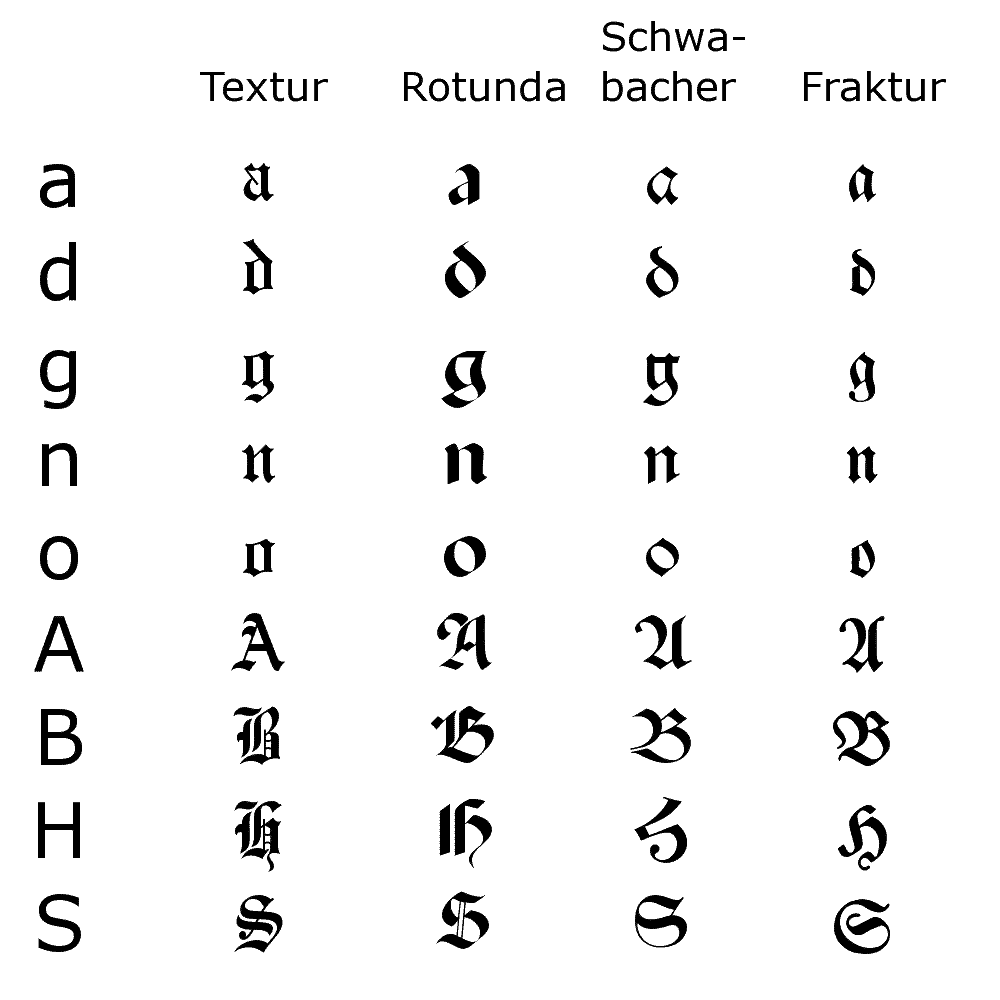
You’ll find two step-by-step tutorials on how to get started with the Textura Quadrata script and the Fraktur script on my website.
By now, the Gothic became the new way of writing across Europe.
Books and legal documents were in high demand, and scribes were the only ones who could perform such tasks at that time.
Scribes and book producers formed guilds, and soon enough, they had a monopoly over book production and legal documents – thus making them very powerful at the time.
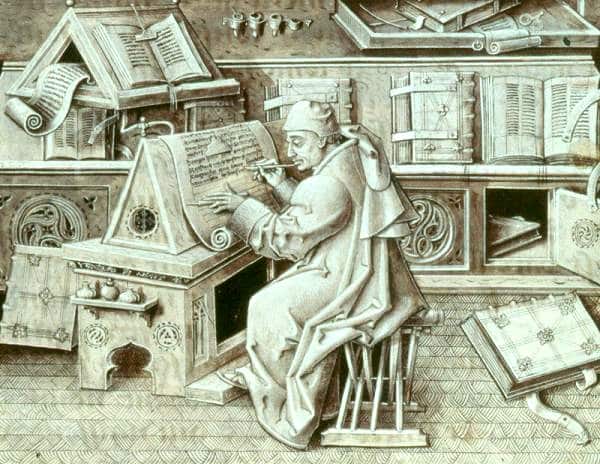
All Good Things Must Come To An End…
One of the most crucial events in the second millennium was the invention of the printing press.
A revolutionary invention by Johannes Gutenberg that brought prosperity to the world but put an end to the scribe.
The printing press (and movable type) broke the monopoly, and simply no scribe could compete with a machine.
The printing press could run over a hundred pages within an hour, while the scribe could only do one.
This massive upgrade allowed millions of books to be printed in a very short period.
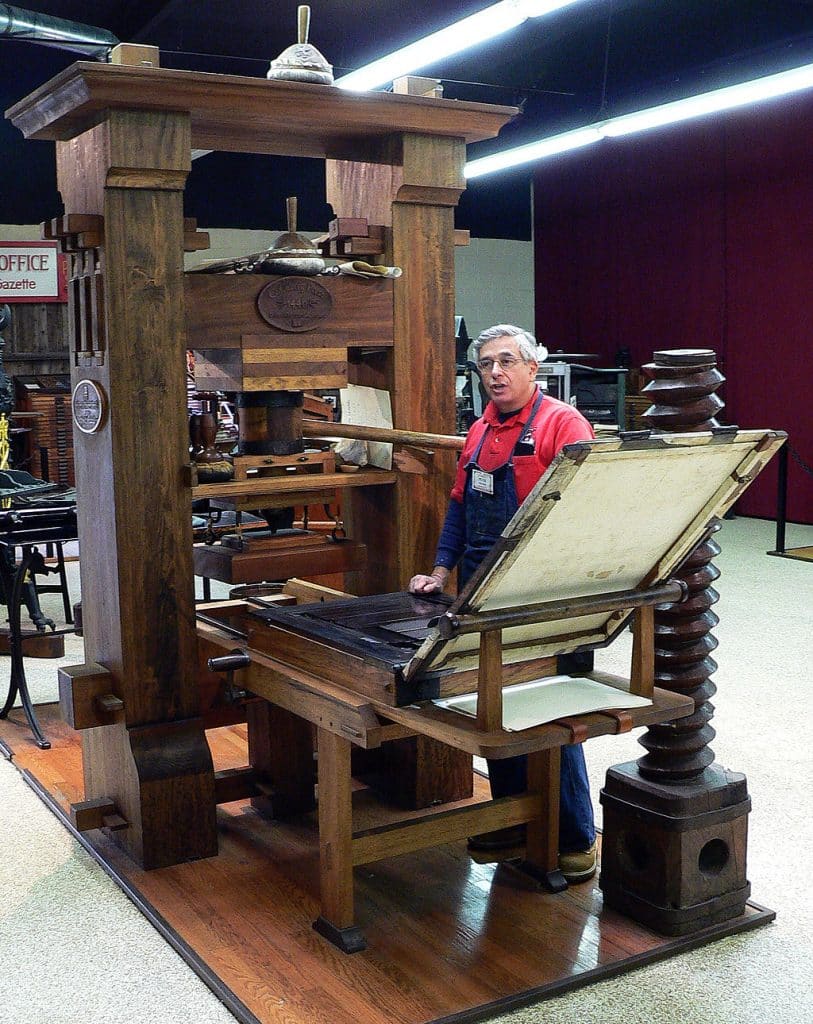
The Renaissance Era
As the year passed, the middle ages ended, and a new era arrived.
An era of ‘’rebirth’’ for Western Europe and upcoming prosperity in major human activities, such as art, science, economy, etc.

At the time, the gothic script that was developed in Northern Europe was the dominant script being used.
However, that particular way of writing did not really resonate with the Italians.
There was one scholar in particular who considered the Gothic to be rather unpractical and who openly criticized it in his manuscripts.
His name was Francesco Petrarca.
Petrarca described it as a script that appeals to the eye from a distance but creates fatigue from up close and that its purpose should be for something other than reading.
Francesco also argued that writing should be clear, simple, and orthographically correct.
These were the notions that gave birth to the Humanist minuscule.
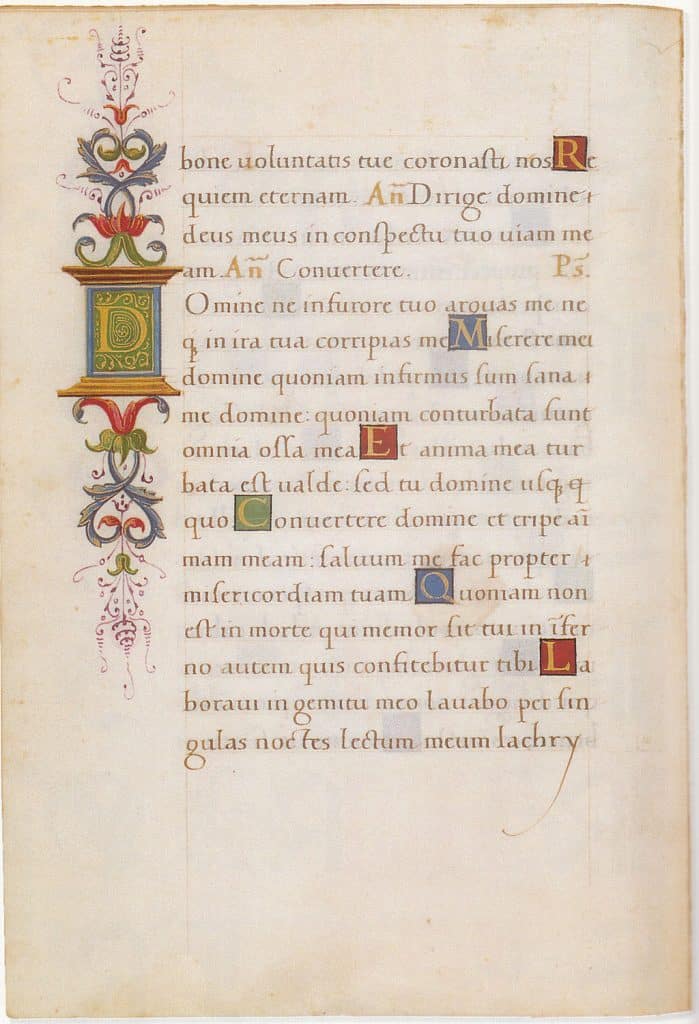
The Humanist Minuscule
This is said to be one of the most significant and defining Western scripts.
It was very popular in Italy at the time, and this script presented a model for the Venetian typeface.
The Humanist minuscule was influenced by the Carolingian hand, as the scholars of that time period were particularly keen on perceiving themselves as the inheritors of the antique era.
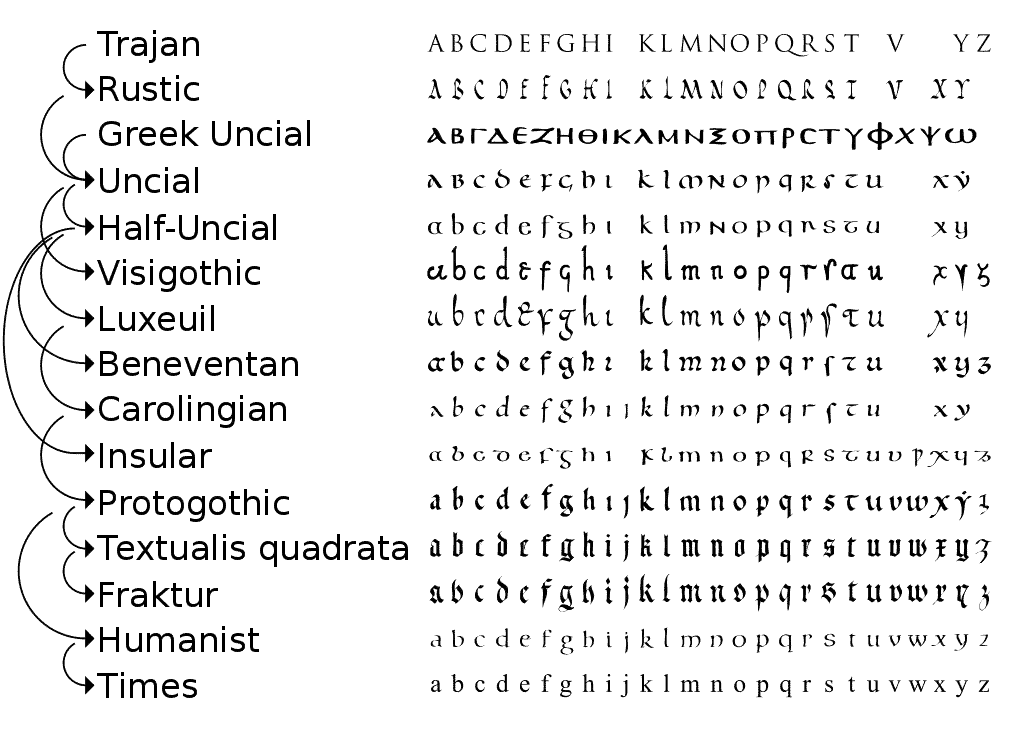
The Cancellaresca Script (Italic)
The Cancellaresca script was another major update in the way people write.
It was particularly innovative because it improved as a script in terms of functionality and speed of writing.
Scholar Niccolò de’ Niccoli was dissatisfied with how laborious the Humanist minuscule was, so he created a slanted script that required fewer strokes and that could be joined with other letters.
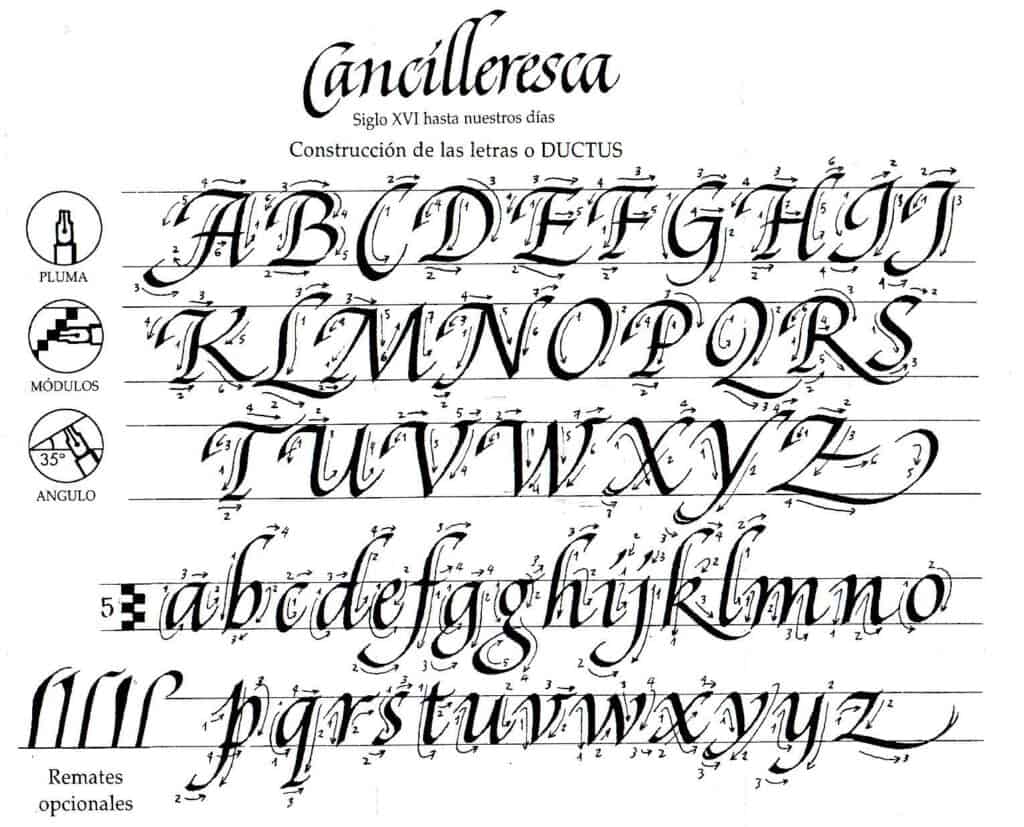
One of the biggest changes was made to the lowercase letter a, which was quite different from the one in the Humanist minuscule script.
Another very important mention about the Cancellaresca script is that it served as a base for cursive writing that we teach and use today.
I wrote a beginner’s guide on how to get started with Italic calligraphy.
The Baroque era
After the period of Rennaisance, the Cancellaresca Corsiva provided the foundation for a new script to be developed.
Fun fact –
The word “cursive” is derived from the Medieval Latin word “cursivus,” which translates to “running.”
Chancery cursive (Cancelleresca corsiva) hand. Papal Letter to Christian II of Denmark, 21 April 1518 (Royal Archives). Source
The Copperplate Script
During the sack of Rome (1527), many scribes moved to the southern parts of France, where they developed the Italic Cancellaresca, which was later adapted to the French style Rhonde in the early 17th century.
It wasn’t until the end of the 17th century when books with the French Rhonde script reached England, where John Ayres and William Banson refined their interpretations of the French script.
During the following years and with the help of fellow writing masters such as Goerge Bickham, the English Roundhand spread across the world due to British Mercantile Trade.
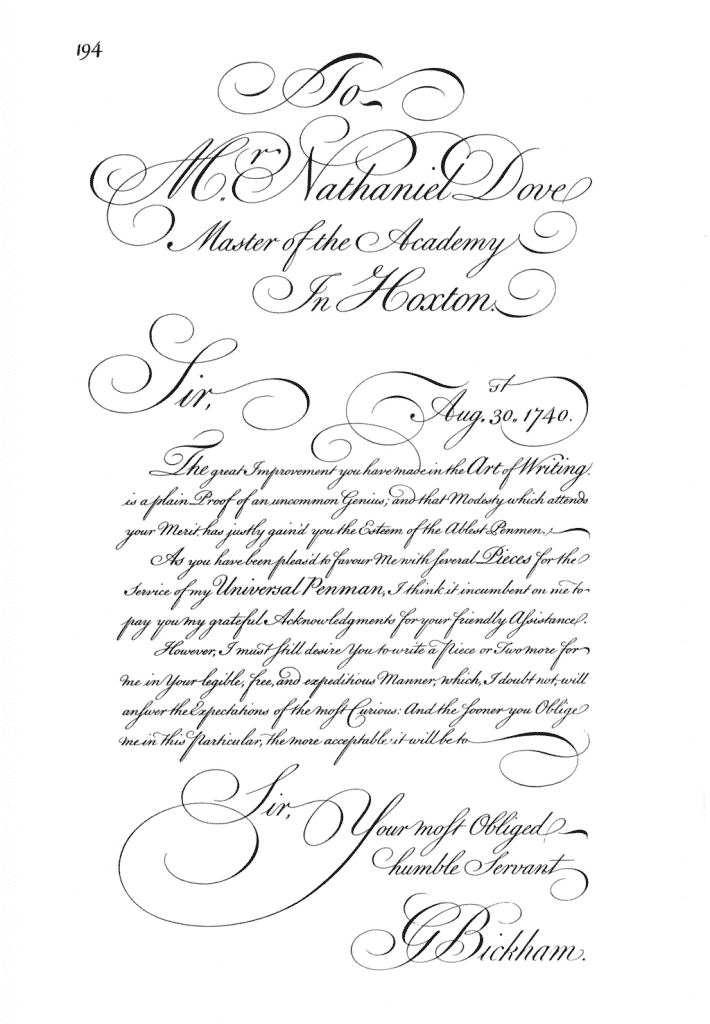
The name Copperplate originates back from when writing was engraved on plates made out of copper, which writing masters would use for printing samples of their beautiful work.
It was being done this way because printing machines and movable type could not reproduce (yet) such complexity and variations of styles.
This fantastic article by Sybille talks more in detail about how the name Copperplate became the standard term for this particular calligraphy style.
On the iampeth.com website, you can find much more information on the history of this particular script and the steps to get started.
I highly recommend that you check it out.
There is also a beginner’s guide on the Copperplate script written by Tri Le that you can check out on my website.
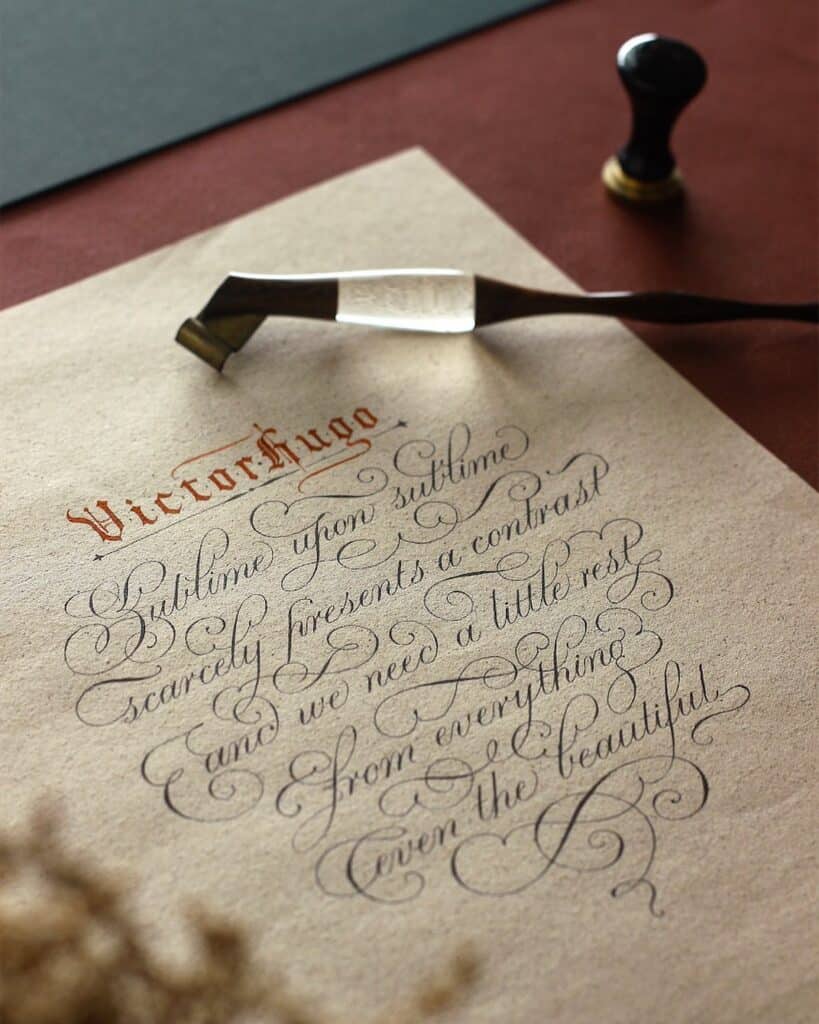
The Spencerian Script
This script originated in the United States and was developed in the 19th century by Platt Rogers Spencer.
Platt Roger Spencer developed a style of penmanship that was used as a standard of writing for nearly a hundred years – up until the point the typewriting machine came along in the 20th century.
What made this script so popular and influential was not only its beauty but also the functionality that lays behind the way you write it.
Fun fact
it is said that the Spencerian script served as an influence point for the Coca-Cola logotype, which we all know is one of the most iconic logotypes in the world.
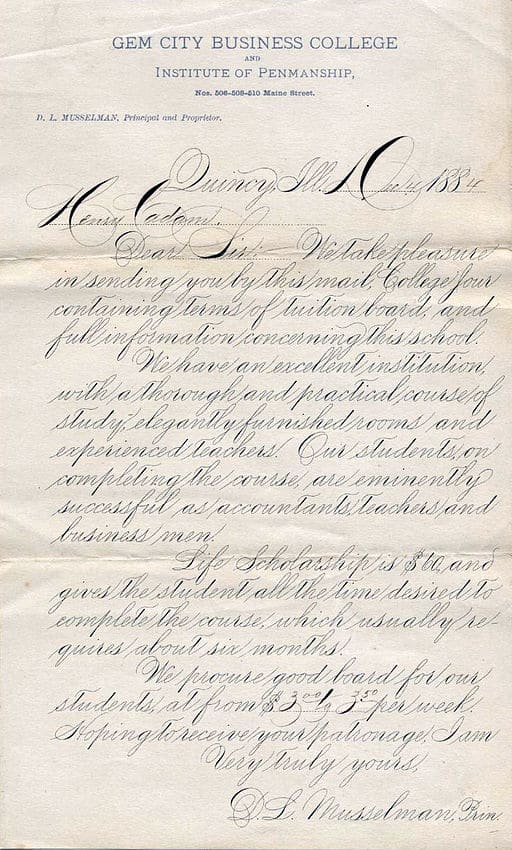
In this article, Dr. Joseph Vitolo talks more in-depth about the Copperplate and Spencerian scripts (as well as their differences) with plenty of examples.
The Modern Era
Although it seemed that machines had turned writing by hand obsolete, calligraphy took various directions, such as advertisement and demand in novelty for type design.
We mark the modern era from the beginning of the 20th century with pioneers such as Edward Johnston and Rudolf Koch – also known as the fathers of modern calligraphy.
Many new developments occurred in the last 100+ years, and it would drag this article out if we were to cover all of it.
Instead, we are going to stick to the most impactful developments.
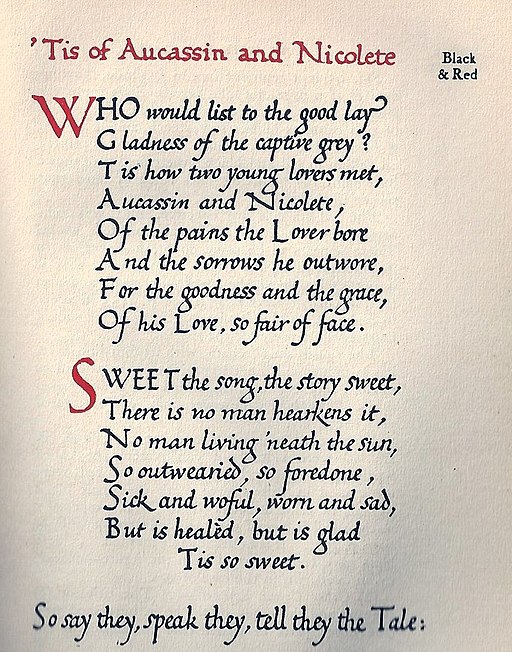
The Foundational Hand
This hand is set to be one of the most iconic alphabets in the whole realm of calligraphy alphabets due to its clearly defined characters.
Edward Johnston devised it in the early twentieth century.
The Foundational hand is an adaptation of the Carolingian script from the post-Roman era.
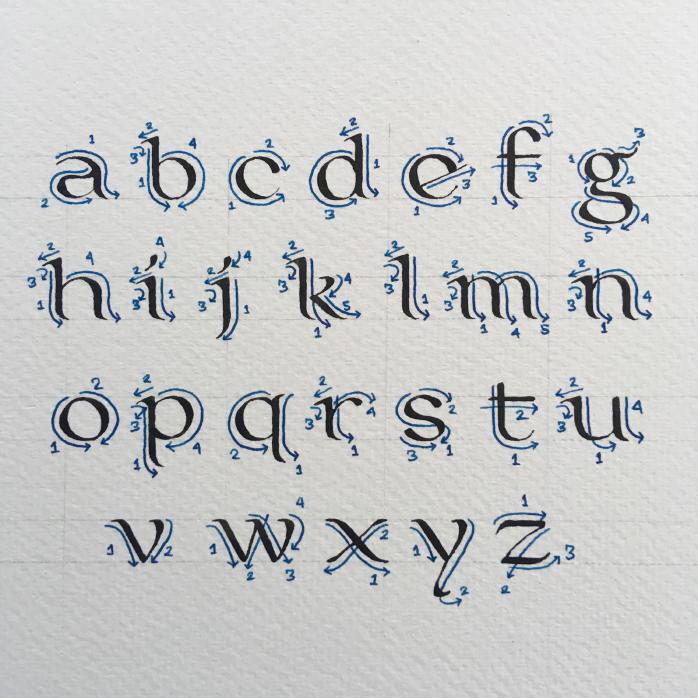
According to Edward Johnston, the Foundational hand is the best script for a beginner to start learning the art of calligraphy.
You can find a full step-by-step tutorial on the Foundational Hand on my website.
Neuland Capitals
Calligrapher and type designer Rudolf Koch designed these capitals in the early twentieth century.
It’s an iconic and vigorous alphabet that many calligraphers still practice all over the world – ideal for large-scale and display work.
Fun fact!
The Neuland typeface was used for the Jurassic Park logo.
Modern Calligraphy Styles
Modern calligraphy is often associated with bouncy and whimsical brush calligraphy, often found on Instagram and Pinterest.
However, it’s much more than that.
Modern calligraphy refers to any writing style that does not adhere to the rules of traditional scripts.
That doesn’t mean scribbling something on paper can be considered modern calligraphy.
There are still standards of quality and beauty that can differentiate a skilled hand from someone just starting.
Also, modern calligraphy is not just related to a single writing tool such as the brush pen.
Modern calligraphy can be done with brushes, broad-edged pens, pointed nibs, markers, and more.
You can create a modern calligraphy script that has its basis in the Copperplate script or even the Fraktur script.
You can also flip the script and create something completely different.
I think that’s exactly the beauty of modern calligraphy.
Nonetheless, I created this beginner’s tutorial on how to start with modern calligraphy (with a brush pen).
Along with it, you’ll find some free downloadable worksheets.
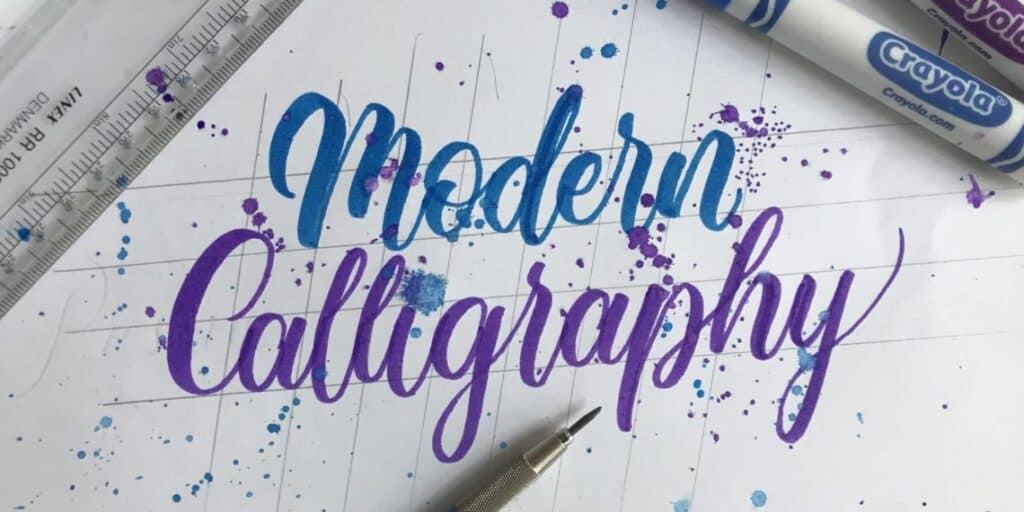
Additional Resources On The History Of Calligraphy
Before we wrap up this article, I wanted to share additional resources for history buffs.
As I mentioned at the beginning of the article, writing a single article on more than 2000 years of history is not easy.
Unfortunately, I simply couldn’t include all the details.
Otherwise, this would have turned into a small booklet rather than an online article.
The first resources I would like to share are three calligraphy books that focus on the history of calligraphy –
- The Art & History of Calligraphy by Patricia Lovett
- Letter Perfect: The Marvelous History of Our Alphabet From A to Z by David Sacks
- Medieval Calligraphy: Its History and Technique (Lettering, Calligraphy, Typography) by Marc Drogin
If you like books, check out my article on the 10 best calligraphy books for beginners.
If you prefer to watch, I have the perfect resource for you!
A documentary from 1980 called Alphabet: The Story of Writing.
In this documentary, master calligrapher Donald Jackson will take you through an exciting journey of the development of the Latin alphabet.
I watched this documentary like five times already, and I love it.
Here you can also watch the second part of the documentary.
Final Words
Calligraphy is becoming more popular by the day, and it’s currently seeing a new ”renaissance” across the globe.
A huge part is due to our technological advancements in recent years and especially the connectivity through social media platforms.
Thanks to the internet and social platforms, we can spread various resources of this beautiful art form – and a perfect example of it is right this moment while you are reading this article.
Hopefully, this article gave you an idea of how the art of writing developed throughout history, and it will also help you choose a script that you would like to learn and practice.
Until the next time,
Stay AWESOME!
Ps – I made this cool infographic about the history of calligraphy. Obviously, it’s a much shorter version that contains only the most crucial developments in history. Feel free to use it in articles, videos or just share it with your friends. All I ask is that you link back to me as the source.

Pin me!
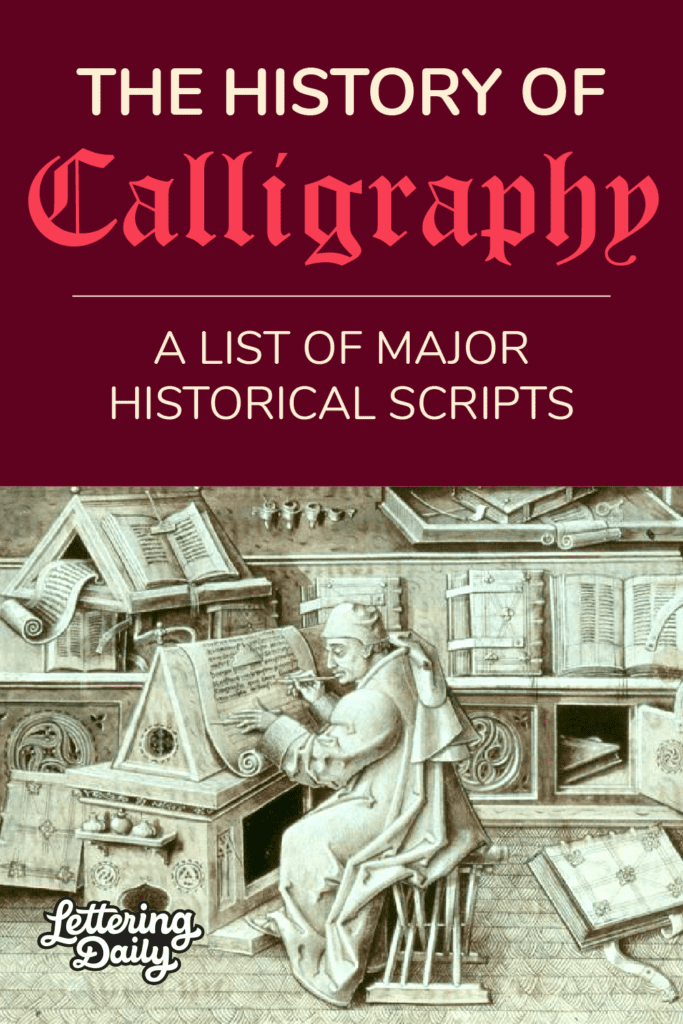
About the author

Meet Max Juric, a dedicated calligraphy and hand lettering artist with over a decade of experience. His artistic journey is deeply rooted in a passion for lettering and a commitment to continuous growth. Max’s extensive experience spans several years as a full-time lettering artist, collaborating with clients from around the globe. Over the past five years, Max has actively shared his expertise, reaching more than 100,000 individuals monthly through a rich array of educational resources. These resources include tutorials, interviews, articles, and podcasts. Max’s practical experience, combined with his unwavering dedication to his craft, sets him apart in the realm of hand lettering and calligraphy. With an educational platform offering over 100 long-form resources, Max aims to guide artists and enthusiasts in enhancing their hand lettering and calligraphy skills. Welcome to Lettering Daily, where artistic expression and learning beautifully intersect.

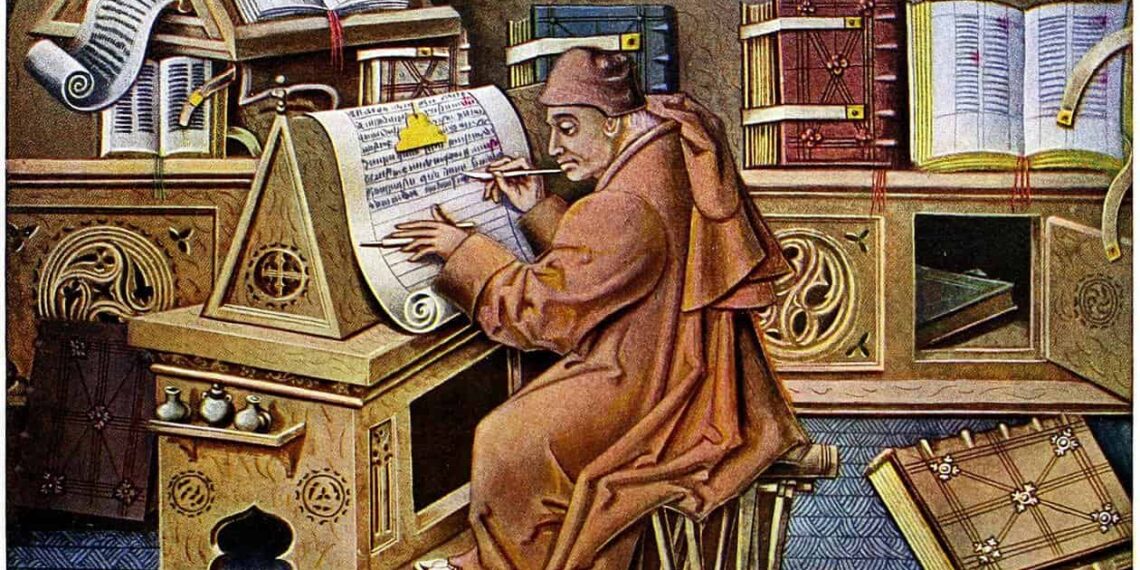

Couldn’t have asked for more! Such an insightful article! Thank you Becca for for the time and effort you put in here that made it so easy for us!
I think you have mixed up something. This article was written by me (Max), and not Becca 😀 She did however wrote this one here – https://www.lettering-daily.com/modern-calligraphy-tips/
I have the same problem as Eileen Harvey. I am left handed. Do you think it is a problem for me to learn calligraphy? With right-handed nibs?
If so, would you know where to find left-handed nibs?
Still, I like to join your group, enjoyed reading it and followed all the links, learned a lot from them!
I think there are nibs better suited for left-handed calligraphers. Nonetheless being left-handed will require you to learn an entirely different technique of writing. Especially if you wish to learn broad-edged calligraphy scripts. Im not sure where you can find them. I’ll have a look around and let you know. It would be good if you sent me an email as well, this way we can keep in touch. An even better idea would be to post this question in the group. With over 10.000 people there, I’m sure someone will be able to help you out with this! 🙂
Hi! I am left-handed and have been doing calligraphy for hire for many years. I had to teach myself to write in a position where I would not come into contact with lettering still wet. Just takes some time and practice, but I do use regular nibs.
That’s great! Left-handed calligraphers always have to struggle but it’s definitely doable 🙂
John Neal Booksellers has calligraphy supplies for left-handers.
https://www.johnnealbooks.com
Yes, thank you for linking that.
When I was a kid in the early 70s (in England) my writing was so illegible my teachers refused to try to mark my work, so my dad forced me to learn chancery script from a book by the marvellously-named John Le F. Dumpleton, which is why I still have fancy handwriting. His version of chancery script had a lovely backswinging d much like the ð eth letter, which is still my favourite letter to write.
Thank you for sharing this story. I will definitely check out the author and his book! 🙂
may I join your group please. I’m only new at calligraphy but intensely interested. I am left handed and am having a time trying to find lefty nibs. However, I bought a cheap set of right handed pens to try. Thank you for producing this great site.
Hey Eileen, absolutely! Everyone is more than welcome to join in our group 🙂 Thank you for the kind words!